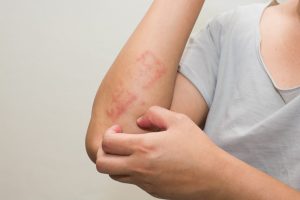Psoriasis is a common and chronic skin disease affecting at least 100 million sufferers worldwide. While it is extremely prevalent understanding more about different forms of psoriasis, causes and treatments are largely unknown.
In honour of Psoriasis Awareness Month being held in August we discuss the different forms of psoriasis and potential treatments to help raise awareness.
What is psoriasis?
Psoriasis is categorized as an auto-immune disorder as the immune system produces excessive skin cells. This leads to chronic inflammation, red, itchy and often scaling plaques on the skin.
The spectrum of severity ranges from mild, affecting only small areas of the body, to severe affecting the entire body. Psoriasis can affect all races, ages and sexes with most diagnosis occurring in early adulthood.
There are several different forms of psoriasis:
- Plaque
The most common form of psoriasis appears as a raised, red patch covered with a silver/white buildup of dead skin cells. These are often itchy and painful and generally occur on the scalp, knees, elbows and lower back. - Guttate
Guttate psoriasis appears as small dot-like lesions and commonly starts in childhood or young adulthood. It can be triggered by a strep infection and is the second most common form making up 10% of cases. - Inverse
Inverse psoriasis is characterized by a very red lesion in the body folds (behind the knee, under the arm or groin). Unlike plaque psoriasis it may be smooth and shiny in appearance. - Pustular
Pustular psoriasis appears as white pustules, containing white blood cells, on red skin. It is not infections or contagious and may affect any part of the body but is most common on the hands and feet. - Erythrodermic
Erythrodermic psoriasis is particularly severe leading to widespread redness over most of the body. It can result in severe itching and pain but is rare occurring in only 3% of psoriasis cases.
What causes psoriasis?
The cause of psoriasis is still largely unknown however genetic predisposition and environmental factors are thought to play a role. It is not uncommon for psoriasis to spontaneously clear for years at a time and resurface later.
As of yet the “master switch” which turns on psoriasis is still a mystery but many note that their symptoms tend to worsen in the colder months.
How to treat psoriasis?
While there is no cure for psoriasis it is controllable with medication. Those with mild psoriasis can typically treat their symptoms with topical products applied to the skin. These include:
- Moisturizers
- Tar preparations
- Dithranol
- Corticosteroid creams or ointments
- Vitamin D
- Ultraviolet light therapy may also be useful to help slow the production of skin cells.
For those with more severe forms of the disease prescribed oral medication or injections may be necessary. Maintaining a healthy diet and regular exercise can also help prevent flare ups of psoriasis.
If you have been diagnosed with or suspect you may have psoriasis it is best to visit your doctor who can help workout a treatment plan that is best for you.





